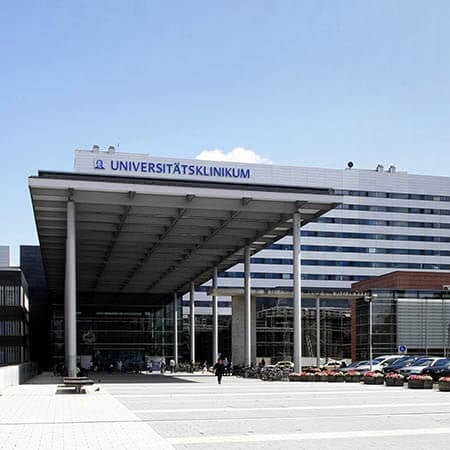Rhabdomyosarcoma is a rare tumor in children. It grows from muscle tissue. In 7-9% of cases, the orbit is affected. The neoplasm begins to grow in the muscles that are responsible for the mobility of the eyeball. Orbital rhabdomyosarcoma is a rare disease that occurs with an incidence of 4.5 cases per million. About 50% of all cases occur before 10 years.
Most children can be cured of the disease in good hospitals. In Europe, mutilating surgery is almost a thing of the past. With the use of sparing surgical interventions, radiation therapy, and chemotherapy, doctors at foreign hospitals can cure rhabdomyosarcoma, saving a patient not only their life, but also their vision. You are welcome to use the Booking Health service to find a hospital and book your treatment abroad on the preferred dates. In developed countries, your child will be treated quickly, reliably, and safely, without health consequences and with a minimal risk of visual impairment.
Content
- Diagnostics
- Surgical treatment
- Radiation therapy
- Chemotherapy
- Why is it worth undergoing treatment abroad?
Diagnostics
The most common symptom of the disease is exophthalmos (bulging eyes). The tumor grows and shifts the eyeball, pushing it out of the orbit. Sometimes rhabdomyosarcoma initially develops in the paranasal region (near the nose) and then spreads to the orbit. The very first symptoms for such patients are facial pain, facial swelling, and headaches.
The disease can be diagnosed with a CT scan. This examination is used to scan the area of the orbit, assessing the size and spread of the tumor. A biopsy is required to confirm the diagnosis. Based on the results of a histological examination, the type of the tumor is assessed, and a patient is assigned to one of the risk groups, which affects the tactics of treatment of orbital rhabdomyosarcoma in children.
The tumor may metastasize. Doctors at foreign hospitals use imaging diagnostic methods for metastasis detection: a chest CT, an ultrasound scan of the abdominal cavity, retroperitoneal space, and regional lymph nodes. A bone marrow biopsy may be performed as well, if clinically indicated.
Surgical treatment
Operations for orbital rhabdomyosarcomas can be organ-preserving and mutilating. Simply put, doctors can remove the eyeball or preserve it by removing only the tumor.
In recent years, radical surgery at the first stage of treatment is rarely used. This is often associated with loss of the eye and a significant aesthetic defect. Therefore, doctors can start treatment with other methods, such as chemotherapy and radiation therapy, and then remove the tumor after it has been reduced in size. Many patients do not require surgery at all, as the neoplasm can be destroyed by radiation and suppressed by chemotherapy.
Types of surgical interventions:
- tumor resection with the preservation of the eye;
- orbital enucleation – removal of the eyeball;
- orbital exenteration – removal of not only the eye, but also the surrounding tissues into which the tumor has invaded.
Modern hospitals in developed countries rarely perform organ removal surgery, but it is still used in countries with poor medicine. To prevent your child from losing an eye, it is better to go to good hospitals that use modern, sparing surgeries and new options of radiation therapy.
In developed countries, organ removal operations are used only if vision has already been lost or the tumor is large and does not shrink under the influence of other treatments. Nonetheless, such cases are rare.
Orbital enucleation is the main organ removal operation. After the eyeball is removed, an implant is placed in its place. This cannot perform a visual function, but allows a patient to maintain a normal appearance. The implant is attached to the eye muscles and can move in sync with the second eye, so others will not notice a cosmetic defect after this operation.
Orbital exenteration is a complex and very rare operation in foreign hospitals, which is performed when a rhabdomyosarcoma extends beyond the eyeball. This involves the removal of not only the eye, but also the tissues surrounding it, such as parts of the eyelid, muscles, and nerves inside the orbit. After enucleation, the eyeball is replaced with a prosthesis as well.
Tumor resection is the mainstay of surgery in developed countries. The tumor is removed and the eye is preserved. It is better to undergo this intervention in a good hospital to avoid complications and preserve your child's vision. An inexperienced surgeon may damage important eye structures, resulting in impaired visual function. There are many specialized centers in Europe that annually perform hundreds of surgical interventions to remove eye tumors. They achieve the best results with a minimal risk of complications.
Radiation therapy
With the advent of new methods of radiation therapy, which are offered in the best hospitals in Europe, the treatment of orbital rhabdomyosarcoma has become more sparing and successful. Now the tumor does not have to be removed along with the eyeball, since the residual tumor mass can be destroyed by irradiation. In addition, many patients do not require any surgery at all: the disease can be often cured with radiation therapy alone, if necessary, in combination with chemotherapy.
Radiation therapy for orbital rhabdomyosarcoma in children can be performed in the following cases:
- after surgery to reduce the risk of recurrence;
- before surgery to reduce the tumor size (surgery is performed at the peak of the effect of chemoradiotherapy, which is usually achieved after 4 months);
- as an independent treatment method for rhabdomyosarcoma without surgery;
- to suppress a recurrent tumor if it repeatedly develops after surgery or chemoradiotherapy.
Brachytherapy
Brachytherapy is considered the main treatment for eye tumors, including rhabdomyosarcoma in children. This is interstitial radiation therapy. The source of radiation is delivered directly to the tumor. This treatment method is invasive, since a special device must be implanted into the eye to irradiate cancer cells, into which radioactive materials will then be injected. This device will stay in the eye for 5-7 days. All of the time a patient is in the hospital.
Despite the invasion, brachytherapy is still safer than external beam radiation therapy. This is due to the fact that radiation does not pass through healthy tissue on its way to the target. This is delivered directly to the tumor and destroys only it. The dose of radiation to the brain is minimal, so side effects are extremely rare.
Intraorbital brachytherapy was first used in 1974 in Cape Town, South Africa. This was used as a safer alternative to external beam radiation therapy after eye tumor removal. Since the end of the 20th century, it has become a standard procedure. Most hospitals use Iodine-125 or Iridium-192 as sources of radiation. Radiation from these radioactive substances penetrates only a few millimeters further than the implant, so healthy tissues are practically not damaged.
Even if the tumor is located near functionally important areas of the eye, modern hospitals achieve a high level of safety for the procedure. Doctors can place additional implants to protect them.
Brachytherapy has the following advantages:
- no significant brain exposure;
- no tissue deformation in the orbit area;
- a low risk of eye complications if you undergo the procedure in a good hospital;
- successful treatment of even tumors with a low sensitivity to radiation (including rhabdomyosarcoma);
- the possibility of use even in patients who have previously been exposed to radiation;
- a uniform distribution of the radiation dose in the tumor;
- a low duration of treatment.
Physicians use brachytherapy both to irradiate a tumor in a patient's eye and to destroy recurrent tumors that have developed after the implantation of a prosthesis.
Possible complications of brachytherapy include radiation-induced cataracts, eyelid ptosis, impaired eye mobility, changes in the skin and underlying tissues in the surgical area, and keratitis. The risk of complications is reduced if you undergo your treatment in a specialized hospital with vast experience in the treatment of intraorbital tumors.
External beam radiation therapy
Remote irradiation can be used less often. Its advantage is the absence of invasion. Radiation is delivered to the tumor without pain and without the slightest discomfort. Doctors use a device located outside the eye. Specialists can irradiate not only the primary tumor, but also metastases.
The disadvantage of external beam radiation therapy is the inevitable damage of radiation to the tissues surrounding the tumor. Therefore, many patients develop complications, especially when using outdated radiation therapy techniques. However, modern hospitals abroad use innovative options of radiation therapy, which have a minimal risk of side effects and complications. Doctors use the following advances:
Gamma Knife delivers radiation from hundreds of different angles. All together, the beams converge on the tumor, so the neoplasm receives a large dose of radiation, and the healthy tissues remain almost intact (the minimum dose of radiation is delivered through them).
CyberKnife System is another radiosurgery option. This is a linear accelerator equipped with a robot-assisted system. There are not many sources of radiation in it, but they quickly move around the head and emit radiation from different angles. Modern frameless stereotactic systems make it possible to carry out radiation therapy without fixing the stereotaxic frame with screws to the periosteum of the patient's skull, which improves treatment tolerance.
Proton therapy is the best method of irradiating eye tumors, especially in children, since their brains have not yet matured, and it is important to protect them from radiation. The complications of radiation therapy are most critical in childhood, as, with significant brain irradiation, intellectual development slows down, and the risk of secondary tumors increases. The cost of treatment with proton therapy is higher than with conventional photon beam therapy, but it is safer. Protons release energy only inside the tumor and almost do not irradiate healthy tissues, passing through them on their way to the target. As a result, doctors can destroy rhabdomyosarcoma without compromising the patient's health.
Chemotherapy
Most patients with orbital rhabdomyosarcoma receive chemotherapy. This treatment option helps doctors to destroy both the primary tumor and its metastases. Chemotherapy and radiation therapy are usually combined, but administered sequentially. In advanced tumors, they can be used simultaneously: while the toxicity of the treatment increases, its effectiveness also increases.
Most hospitals use the VAC regimen. Its use often leads to the complete disappearance of tumors. However, the tumor may return in the distant future, so radiation therapy is usually necessary even in a complete response to treatment. This helps the patient to prevent a rhabdomyosarcoma recurrence.
Why is it worth undergoing treatment abroad?
In good hospitals, doctors achieve excellent results in the treatment of orbital rhabdomyosarcoma: the five-year survival rate of patients is close to 100%, and in 90%, the disease will be completely cured. Even in the event of a recurrence, the situation is not considered hopeless. The tumor can be removed or destroyed by radiation, and the disease can be cured with a high probability, albeit on the second attempt.
There are a few reasons for treating orbital rhabdomyosarcoma in a modern hospital abroad:
- organ-preserving operations instead of orbital enucleation and exenteration;
- a high percentage of cured patients;
- a low risk of recurrence;
- successful treatment of even common and recurrent tumors;
- the most advanced methods of brachytherapy and external beam radiation therapy, which destroy the tumor with a minimal risk of complications;
- modern chemotherapy regimens, which are effective, and, at the same time, safe, without the use of outdated, highly toxic regimens.
With the help of the Booking Health service, you can find the prices in different hospitals, compare the cost of treatment, and make your appointment at a favorable price. The Booking Health specialists will help you to select a hospital and arrange your treatment abroad. Prices will be lower for you due to the lack of additional fees for foreign patients.
Authors:
The article was edited by medical experts, board-certified doctors Dr. Nadezhda Ivanisova and Dr. Sergey Pashchenko. For the treatment of the conditions referred to in the article, you must consult a doctor; the information in the article is not intended for self-medication!
Sources:
National Library of Medicine
MedicineNet
Verywell Health



















